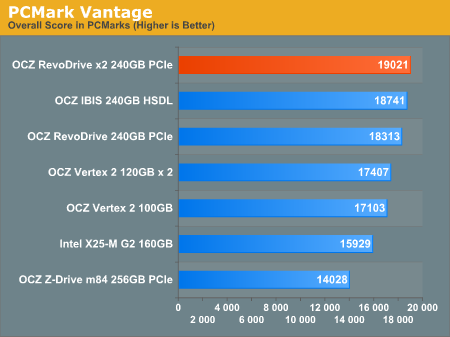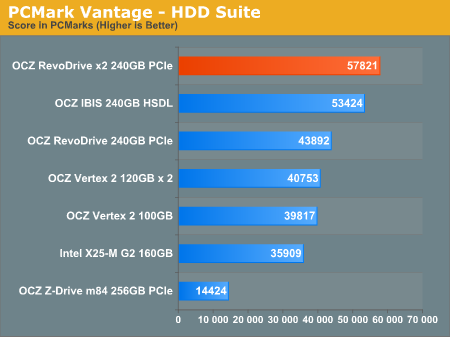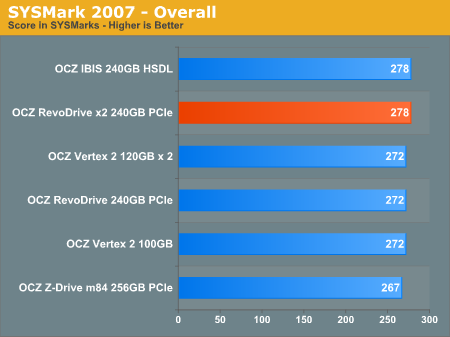A Quick Look at OCZ's RevoDrive x2: IBIS Performance without HSDL
by Anand Lal Shimpi on November 4, 2010 1:05 AM EST- Posted in
- Storage
- SSDs
- OCZ
- RevoDrive
- RevoDrive x2
The Test
Note our AnandTech Storage Bench doesn't always play well with RAIDed drives and thus we weren't able to run it on the RevoDrive x2.
| CPU | Intel Core i7 975 running at 3.33GHz (Turbo & EIST Disabled) |
| Motherboard: | Intel DX58SO (Intel X58) |
| Chipset: | Intel X58 + Marvell SATA 6Gbps PCIe |
| Chipset Drivers: | Intel 9.1.1.1015 + Intel IMSM 8.9 |
| Memory: | Qimonda DDR3-1333 4 x 1GB (7-7-7-20) |
| Video Card: | eVGA GeForce GTX 285 |
| Video Drivers: | NVIDIA ForceWare 190.38 64-bit |
| Desktop Resolution: | 1920 x 1200 |
| OS: | Windows 7 x64 |
PCMark Vantage & SYSMark 2007 Performance
With a four controller SF-1200 setup the real performance advantage won't be seen on most desktop workloads. The RevoDrive x2 is only a few percent faster overall than the original RevoDrive and about 10% faster than a single OCZ Vertex 2.

In the HDD suite the performance advantage is much greater. The RevoDrive x2 is also a bit quicker than the IBIS, perhaps because of the lack of overhead posed by the HSDL interface. There's a 31% performance improvement over the original RevoDrive.

SYSMark shows that most CPU bound desktop workloads won't be impacted by the RevoDrive x2. If your applications are IO bound, expect to see an impact but otherwise there's not much to gain here.











46 Comments
View All Comments
me&er - Thursday, November 4, 2010 - link
Anand,I've Secure Erased both Revo x2 and IBIS a number of times using hdparm.
Infact, it's my preferred method with all SSD.
Here's the methodology:
http://www.ocztechnologyforum.com/forum/showthread...
Regards,
ezinner - Thursday, November 4, 2010 - link
Argh! Why do motherboard and peripheral manufacturer's take so long to release port upgrades? They churn out new processors and chipsets all the time, but lag behind on interconnecting high speed devices. I am so sick of the USB 2.0, serial and parallel ports still found many motherboards. Give me USB 3 and the new Intel optical interface. First you have to mass market them, then devices will come out that supprt them. Give us faster lanes. Music vendors are even worse. Keyboards still were using floppy drives and scsi ports during the last decade and use slower, lower capacity sd-ram.Kevin G - Thursday, November 4, 2010 - link
Chipsets are proprietary but high speed interconnects like SATA, USB ect. are industry standards which anyone can make devices for. Proprietary designs are easier to build as the designers know exactly the limited number of devices they interface with.The other issue with standards is that until chipsets include them, they'll incur an extra cost via an external chip for motherboard manufacturers. Thus even though the standard is complete and available, there will be some resistance for acceptance.
anon1234 - Thursday, November 4, 2010 - link
Does this card offer management of the RAID controller, i.e. can the RAID be turned off (JBOD mode)? There are a couple of scenarios where having 4 separate 'drives' is preferable to a single stripe set.Does TRIM still work if you do RAID/striping in software?
Spazweasel - Thursday, November 4, 2010 - link
Don't underestimate the value of ease-of-installation. That can add up pretty quickly to even a moderate sized organization. If it only takes a couple of minutes to install or swap a drive-on-a-card, versus drive-in-a-HD-format, you can make up the premium in price quickly.wojtek240 - Friday, November 5, 2010 - link
I somewhat liked the review but the ad and the review at the same time, its just a bit too much Ananad, credibility is still #1 for some folks.JarredWalton - Friday, November 5, 2010 - link
Advertisements are from a completely separate company, and they're basically "randomly" selected. I say randomly in quotes because I'm not even sure of all the details--some company could buy all of the storage ad space for a month if they were so inclined. I've read many a magazine where an ad appears opposite a review, and in some cases those are very negative reviews.Any good (and smart) company keeps editorial staff separate from the advertising, and AnandTech operates that way. I can say with 100% honesty that no one has ever asked me to deal with advertising, and that never once has anyone suggested I give a better review to a product because they're "a big advertiser." In fact, I know of a couple instances where companies have threatened to pull advertising because of negative (or at least not glowing) reviews, and Anand pretty much said see you later.
Other than that, I'm not sure what in this article would undermine credibility based on the ads anyway, as my impression is more of a, "yeah, it works, and it's like RAID-0 with four SSDs only you use a single PCIe slot. It carries a price premium as well, secure erase can be iffy, TRIM doesn't work so you have to depend on idle garbage collection, and we encountered a bug on SandForce when writing lots of uncompressable data". That's definitely not enough for me to want to jump at the Revo X2, especially considering the price.
adonn78 - Friday, November 5, 2010 - link
How much faster will it boot my PC over other SSD's or RAided drives? how long will it load a level of the 5 most popular games? Five us real world tangible statistics... IO's mean nothing to a gamer.krazyderek - Friday, November 5, 2010 - link
the OCZ vertex 2 120gb x 2 seems to be lacking QD32 benchmarks to compare it at the same performance metric, also shouldn't OCZ vertex 2 120gb x 4 also been included since that's the apples to apples comparison to a revo drive x2 in terms of controller count??And for that matter, why isn't the original revodrive shown for reference aswell?
i'm blown away by the revodrive x2 unfortunately that's cause there aren't any other numbers to compare it too...
AnnonymousCoward - Friday, November 5, 2010 - link
I couldn't find the PCIe gen in this article or the original RevoDrive one. Another site says it's PCIe 1. With all the talk about bandwidth, this is relevant. So PCIe 1 x4 = 1GB/s, and you used 804MB of that.Also, the charts are sort of hard to read with all the text and common colors; here's a way to improve it: http://i53.tinypic.com/3480bw4.png
Otherwise, good review. I think motherboards need to start including non-graphics multi-lane PCIe to accommodate high bandwidth drives.